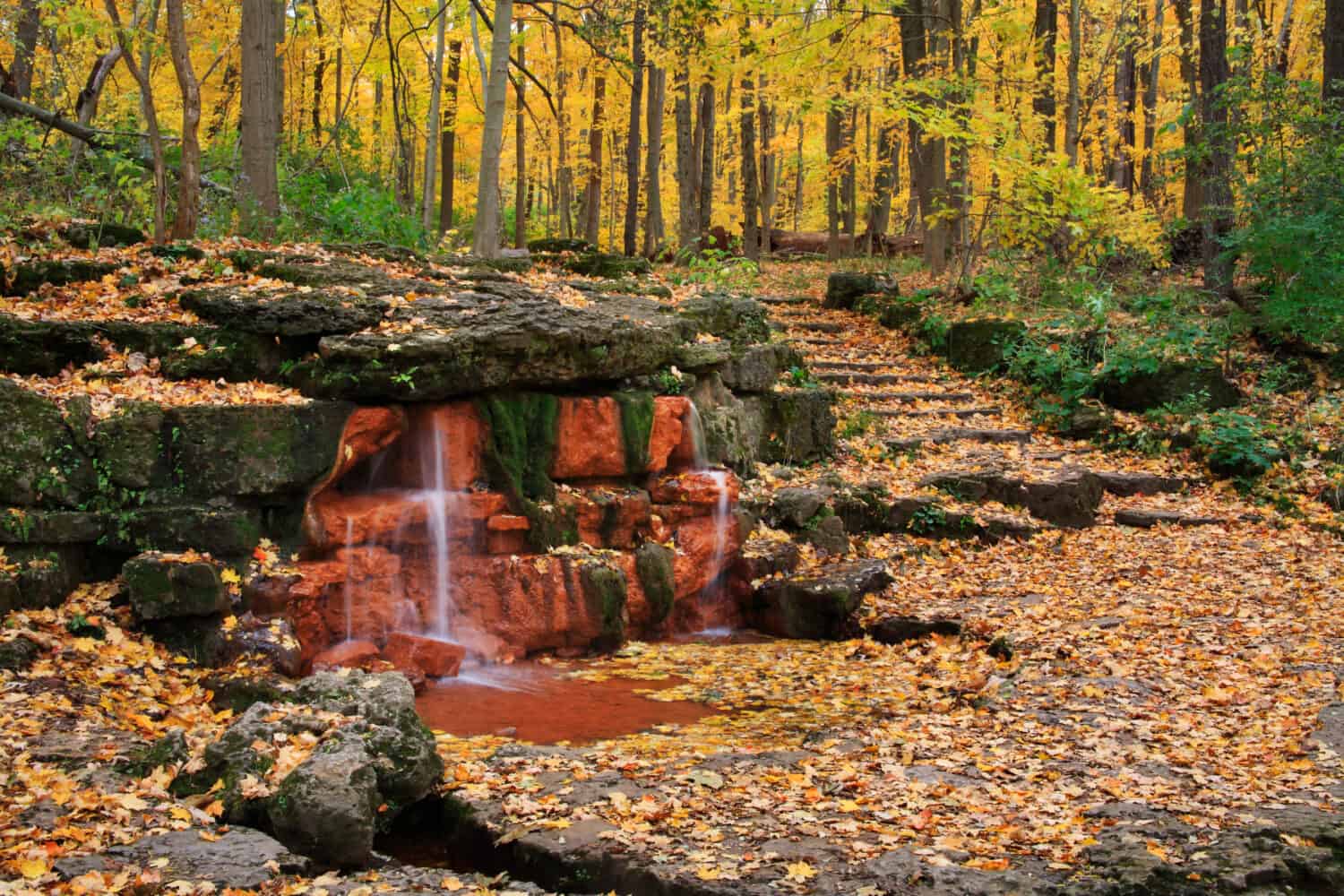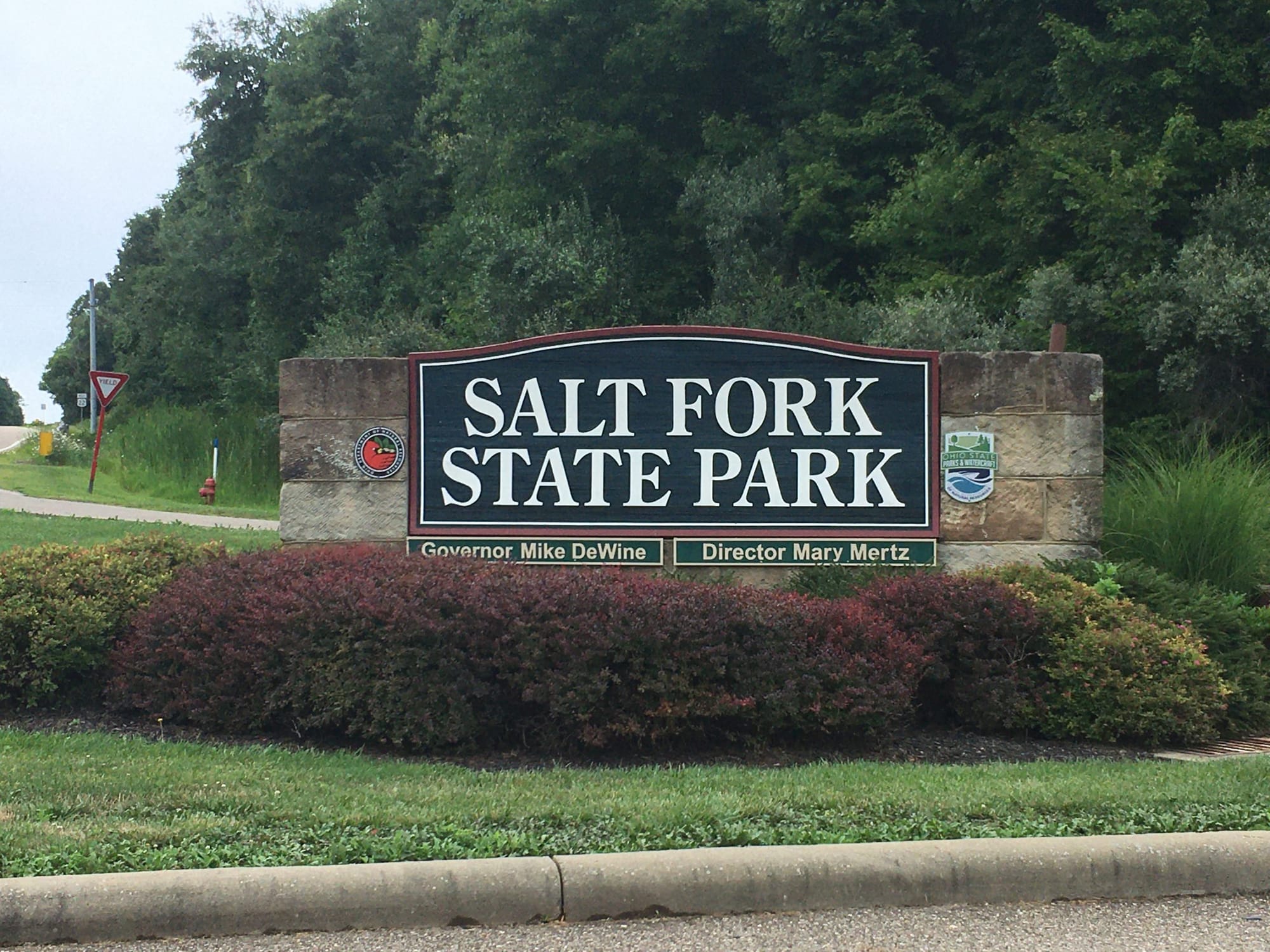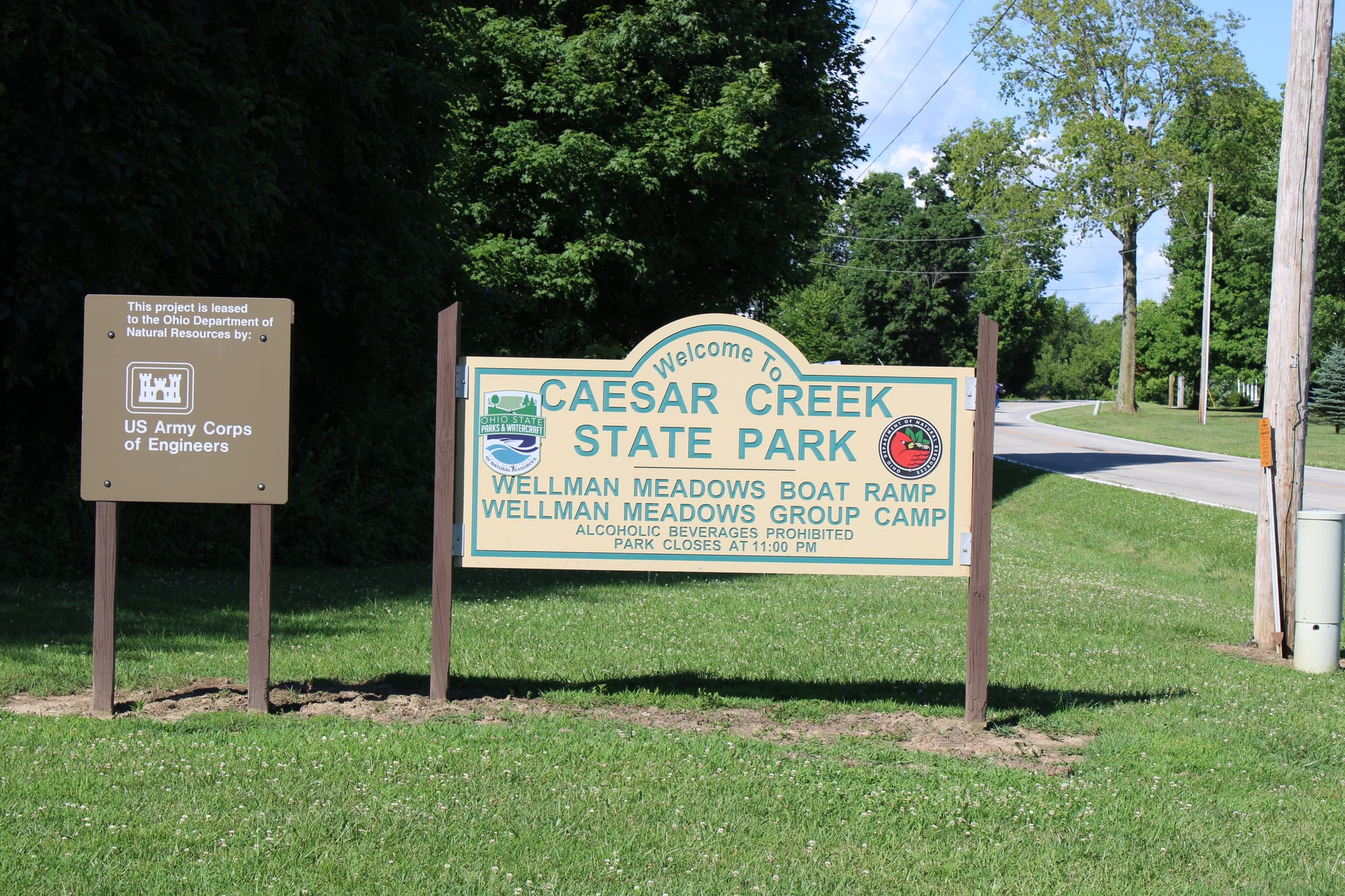John Bryan is a scenic state park in western Ohio. The 752-acre park contains a limestone gorge cut by the Little Miami River which is designated as a state and national scenic river. A portion of the gorge itself is designated as a national natural landmark.

Clifton Gorge State Nature Preserve, Glen Helen Nature Preserve, Clifton Mill and Yellow Springs Village are located close to one another. It is hard to separate into separate blogs, so I didn't.
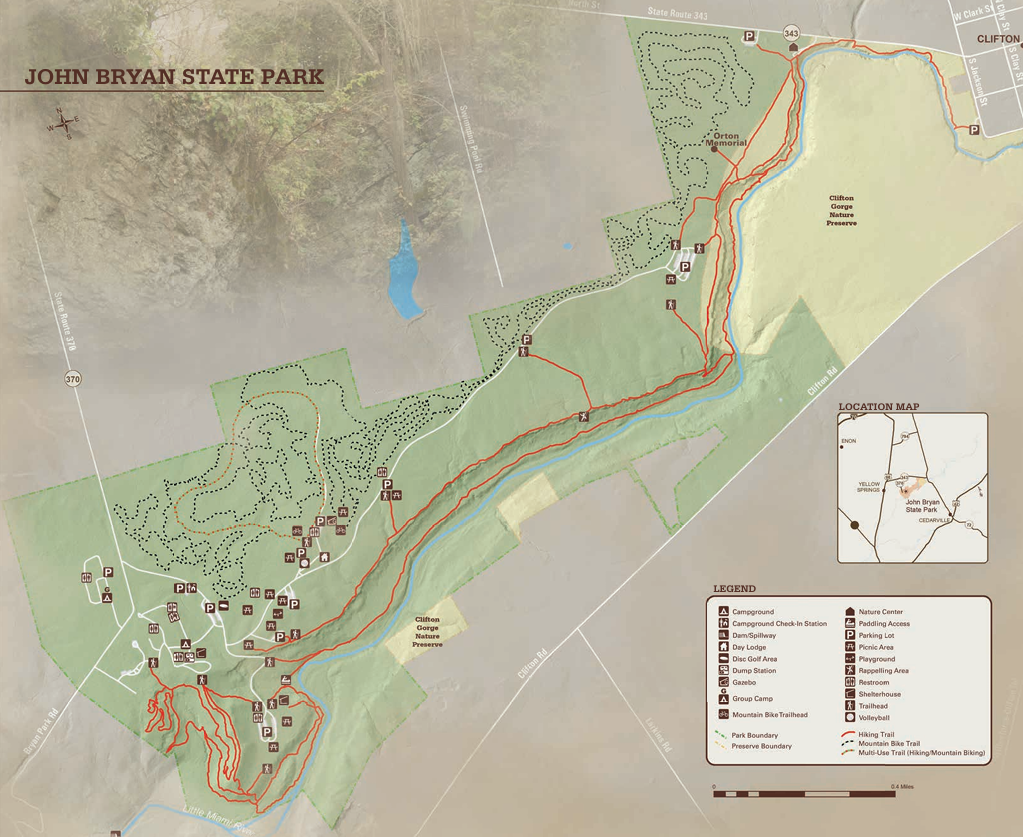
History of John Bryan State Park
This park was named in honor of John Bryan, an Ohioan known for his contributions to the region, including his work in conservation and community service.
John Bryan (1826-1895) was a notable figure in Ohio's history, known for his contributions to the region's development and his involvement in various social and political causes.
Bryan was well-educated, attending local schools and later studying at Miami University in Oxford, Ohio.
He was a strong advocate for the preservation of natural landscapes and the protection of public lands. His efforts were instrumental in the establishment of parks and natural preserves in the region.
In recognition of his contributions to the region and his advocacy for conservation, John Bryan State Park was established in 1958. The park, located near the village of Yellow Springs, Ohio, preserves part of the scenic Clifton Gorge and provides recreational opportunities for the public. The park's creation was a tribute to Bryan's efforts to protect and enhance natural areas in the region.
- Establishment: John Bryan State Park was established in 1958. It was named in honor of John Bryan, a prominent Ohioan who was known for his contributions to the local community and his advocacy for conservation and public lands.
- Location: The park is situated in southwestern Ohio, near the village of Yellow Springs, and it encompasses part of the scenic Clifton Gorge, an area known for its dramatic gorge and river views.
- Development: The park was developed to preserve the natural beauty of the Clifton Gorge area and to provide recreational opportunities for the public. It is part of a larger conservation effort to protect and enhance the natural environment of the region.
.jpg)
.jpg)
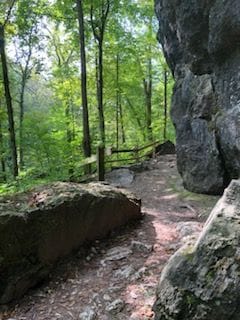
Trails in and Around Yellow Springs
1. Clifton Gorge Trail
- Length: Approximately 4 miles (round trip)
- Description: This trail follows the Clifton Gorge along the Little Miami River. It features dramatic gorge views, rocky outcrops, and diverse vegetation. The trail provides several scenic overlooks.
- Difficulty: Moderate to strenuous. It includes uneven terrain and some steep sections.
2. John Bryan Trail
- Length: About 6 miles (round trip)
- Description: The John Bryan Trail connects to the Clifton Gorge Trail and traverses various landscapes including woodlands and riverbanks. It offers extensive views of the park's natural beauty.
- Difficulty: Moderate. The trail has some elevation changes and flat sections, suitable for most hikers but can be demanding over longer distances.
3. Cedar Falls Trail
- Length: Approximately 2 miles
- Description: This shorter trail leads to Cedar Falls, a picturesque waterfall. It features some rugged terrain and elevation changes.
- Difficulty: Moderate. The trail can be steep and rocky, especially near the falls.
4. Yellow Springs Trail
- Length: Varies (approximately 2-3 miles)
- Description: This trail connects the park with the village of Yellow Springs, offering a mix of wooded and open areas. It provides a connection between the natural areas and the village.
- Difficulty: Easy to moderate. The trail is mostly flat and well-maintained but can vary depending on the specific route.
5. Glen Helen Nature Preserve Trails
- Length: Various trails totaling about 25 miles
- Description: Located just outside Yellow Springs, the Glen Helen Nature Preserve offers a network of trails through diverse habitats including forests, meadows, and along the stream.
- Difficulty: Varies from easy to moderate. Trails offer a range of experiences from gentle walks to more challenging hikes.
6. Little Miami Scenic Trail
- Length: Approximately 78 miles (total trail length, with segments accessible from Yellow Springs)
- Description: This multi-use trail follows the Little Miami River and provides scenic views, access to parks, and connections to other trails. It is ideal for walking, biking, and running.
- Difficulty: Easy to moderate. The trail is generally flat and well-maintained.
Several points along the trails offer spectacular views of the Clifton Gorge and the Little Miami River.
Visiting Information
John Bryan State Park is open year-round, but specific facilities may have seasonal hours. Always check for the latest information on park hours and conditions.
3790 State Route 370, Yellow Springs, OH 45387
Phone (937) 767-1274
The park’s visitor center provides maps, trail information, and additional resources for visitors.
Yellow Springs a Natural Spring
The town of Yellow Springs was named for a natural spring. It was known for its healing properties.
But don’t drink the water.
The spring was discovered in the 1800s and its claim to fame from rumors that drinking from the spring cured various health conditions. Although the rumors might be true, drinking from unpurified water isn’t always safe.
High iron in the water leaves yellow deposits on the surrounding rocks, giving it its name.
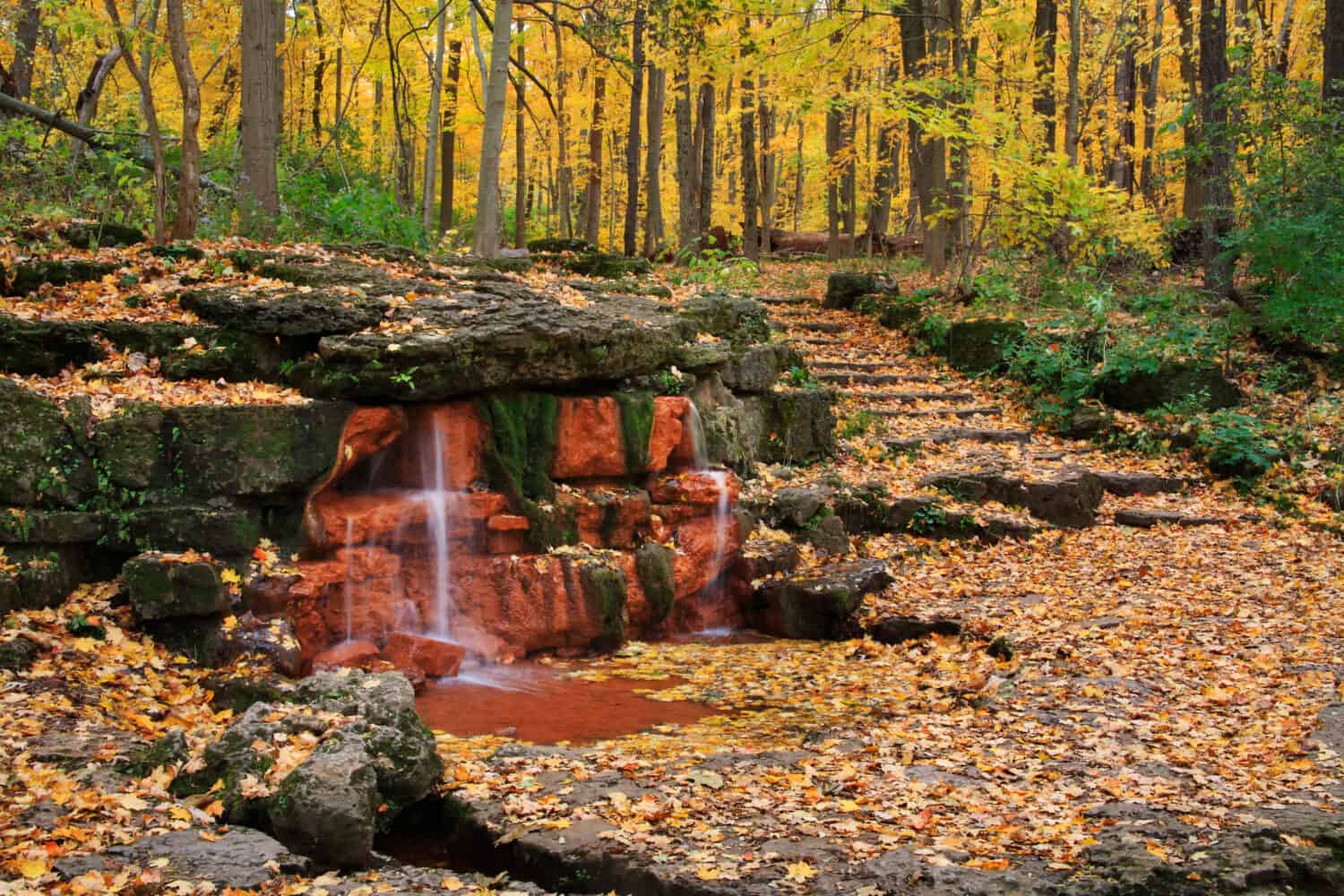
The Village of Yellow Springs
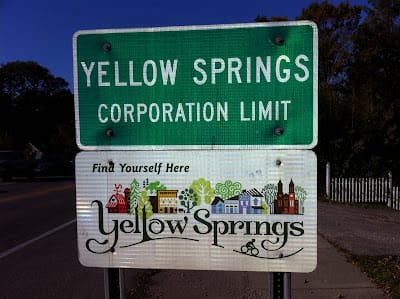
Native Americans, including Tecumseh, once called the surrounding forests their home.
In 1825, Yellow Springs was inhabited by the Owenites, a short-lived cooperative community.
The Reverend Moncure Daniel Conway arrived in town with a group of free slaves, in 1862. He believed they could live a safe and prosperous life in Yellow Springs.
The healing waters of the Yellow Springs, where the village derived its name, spurred the development of resorts and health spas in the village.
The arrival of the Little Miami Railroad in 1846 provided further economic growth and prosperity to Yellow Springs. The railroad brought visitors to the resorts and goods to the local businesses.
The opening of Antioch College in 1853 provided the village with a strong educational foundation.
The Village of Yellow Springs has approximately 4,000 residents and is located in Greene County in southwestern Ohio. Yellow Springs is known today as an eclectic village of artisans, educators, and musicians.
Recreational Activities
Extensive recreational attractions include the Little Miami Scenic Trail for cycling; 2000 acres of woodland and rivers edge hiking trails in Glen Helen, John Bryan State Park and Clifton Gorge; a swimming pool, skate park, playgrounds, soccer and baseball fields, basketball and tennis courts.
There is the Little Miami Bike Trail which runs through Yellow Springs which is part of the nation’s largest network of paved, off-street trails, bike, hike or rollerblade through woodlands, farms and towns on this picturesque trail through Southwest Ohio.
In addition to hiking, visitors can enjoy picnicking, fishing, and birdwatching. The park includes picnic areas and a campground for overnight stays.
The park’s wooded campground offers 50 electric and non-electric sites. It's great for tent camping. Most sites are partially shaded and equipped with picnic tables and fire rings. Pets are permitted on all sites. Reserve through the Ohio Department of Natural Resources website.
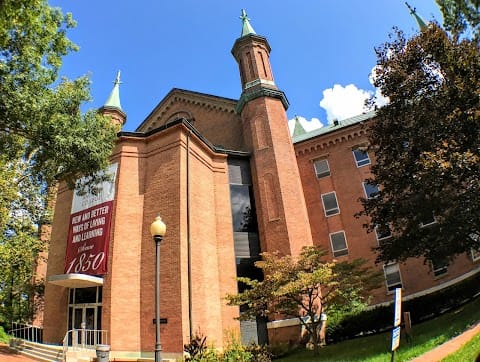
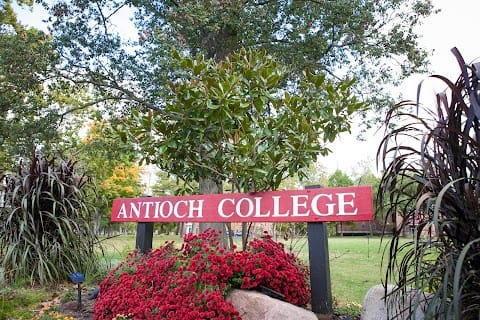
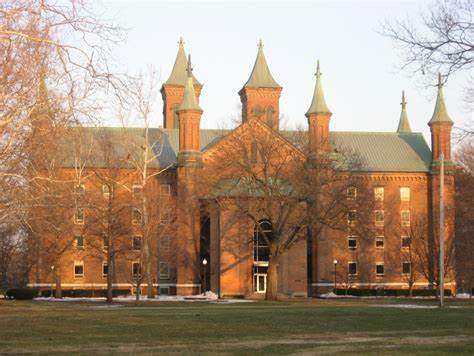
Antioch College
Antioch College, located in Yellow Springs, Ohio, was founded in 1852. It was established by a group of New England Transcendentalists, including the influential abolitionist and social reformer Horace Mann. The college was named after the ancient city of Antioch, symbolizing its mission to provide a progressive education.
Horace Mann, first president of Antioch College, was an abolitionist and educational visionary. He was father of Antioch College and of the American public school.
The College was among the first nonsectarian educational institutions in the United States. It was the first coeducational college in the nation to offer the same educational opportunities to both men and women.Iit was the first to appoint a woman to its faculty and to its Board of Trustees. It was also among the first to offer African-Americans equal educational opportunities.
Antioch College Symbol

Into its symbol—created in 1950—Antioch College has designed several meanings. Composed of symmetrical geometrical figures—and inspired by Leonardo daVinci’s “Vitruvian Man”—this “circle, square, triangle” symbol suggests the ideal of symmetry and balance in education.
Hippie Culture in Yellow Springs, Ohio
 - Copy.jpg)
 - Copy.jpg)
Yellow Springs, Ohio, has a notable connection to the counterculture and hippie movement of the 1960s and 1970s. when the United States experienced significant social upheaval and the rise of the counterculture movement. This movement was characterized by a rejection of traditional values, experimentation with alternative lifestyles, and a focus on peace, love, and communal living.
Hippies, who were central to this movement, embraced values such as environmentalism, pacifism, and alternative medicine, often challenging societal norms. Yellow Springs, Ohio, became a significant center for hippie culture. The legacy of this era is still present in the town’s vibrant arts scene, progressive values, and commitment to social and environmental issues.
Antioch College was crucial role in attracting counterculture figures to the village. The college was known for its progressive education, social activism, and involvement in the civil rights movement, which aligned with the values of many in the hippie community.
The Cincinnati-Pittsburgh Stage Road
A historic stagecoach trail formerly ran through what is now John Bryan State Park. The Cincinnati-Pittsburgh Stage Road served the surrounding area, and several enterprising settlers began establishing water-powered industries in the gorge.
One textile mill built in 1806 spanned the gorge with an innovative cantilever design, offering access on both sides of the Little Miami River. At one point there were 14 mills in the area.

.jpg)
Most of the mills were abandoned by the late 1800s and quickly fell to ruin, although the Clifton Mill in nearby Clifton has been preserved for modern day tourists.
Remnants of the foundations of the other historic mills can still be seen by observant hikers, and a portion of the park’s rim trail follows the old stagecoach road.
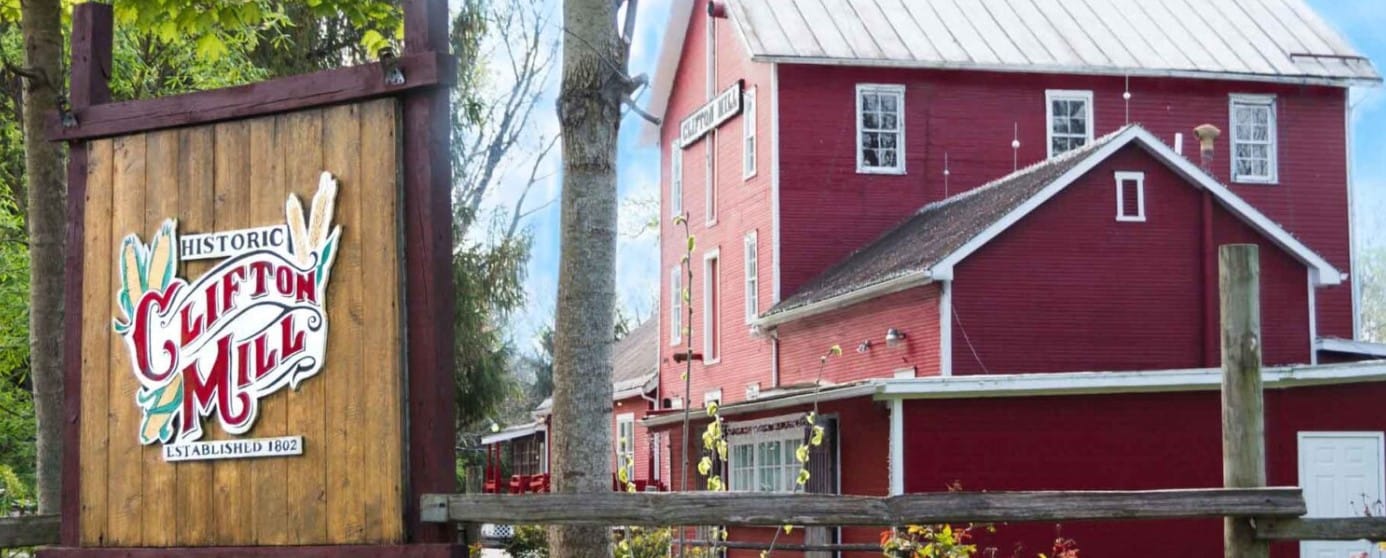
The Civilian Conservation Corps (CCC) developed the park facilities. The CCC arrived at John Bryan in June 1935 to begin six years of work. The men laid out roads and blazed miles of trails, including the Pittsburgh–Cincinnati Stagecoach Trail, preserving a fragment of the 19th-century wagon road.
Because of the CCC, the old stage road exists for a new type of public use. The Pittsburgh-Cincinnati Stagecoach Trail winds two miles along the Little Miami River until it climbs to the top of the bank near the foundation of the old paper mill.
After being closed for several years, the South Gorge Bridge along this trail is now open.
Clifton Gorge State Nature Preserve
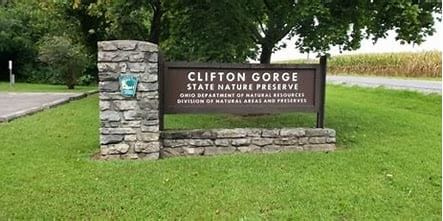
This 268-acre preserve protects one of the most spectacular dolomite and limestone gorges in the state.
Registered as a National Natural Landmark in 1968, Clifton Gorge encompasses a 2-mile stretch of the Little Miami State and National Scenic River, just east of John Bryan State Park.
It is located at:
Address: 2381 State Route 343, Yellow Springs, OH 45387-8808
Phone: (614) 265-6453
Open 1/2 hour before sunrise, 1/2 hour after sunset
3 miles of hiking trails:
- Gorge Trail - 1 mile
- Narrows Trail - 0.5 mile
- Orton Trail - 0.5 mile
- Rim Trail - 1 mile
Glen Helen Nature Preserve
Glen Helen is the legacy of alumnus Hugh Taylor Birch, who, in 1929, donated the wooded glen to Antioch College in memory of his daughter, Helen. With this gift, a foundation was laid to establish the Glen Helen Nature Preserve. Additional gifts have expanded the preserve, which now encompasses 1,125 acres, all accessible from a 15-mile network of footpaths. Antioch College completed a conservation easement in 2015 through the Tecumseh Land Trust to ensure it would be preserved in perpetuity against development.
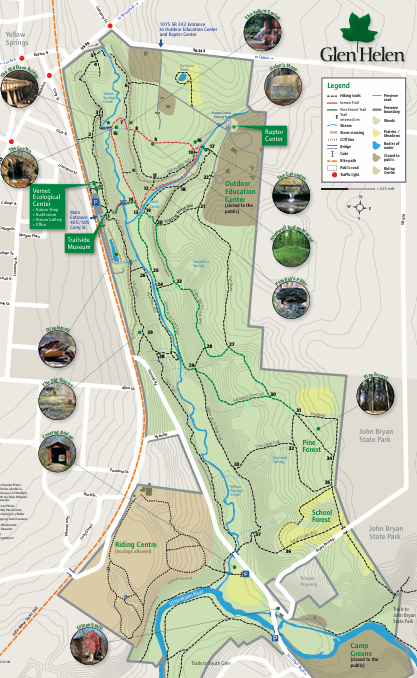
It is home to the first residential environmental learning facility in the Midwest and Ohio’s original facility for education and rehabilitation of birds of prey.
Within our borders, it shelters nearly two miles of the State and National Scenic Little Miami River and one of Ohio’s only National Natural Landmarks.
The Glen Helen Association came together in 1960 to successfully fight a pair of threats to the future of Glen Helen Nature Preserve – a highway bypass for what is now US 68, and a municipal sewer line for the Village of Yellow Springs.
In September 2020, the Association made an agreement with Antioch College and assumed ownership and responsibility for operating the preserve and its programs.
The Glen has become the largest, and most visited private nature preserve in the Miami Valley.
https://www.glenhelen.org/visit
Conclusion
There is much to see and do at John Bryan State Park. The hiking is wonderful. Clifton Gorge State Nature Preserve is breathtaking. Also, Clifton Mill is a fun place to visit as well as Yellow Springs. I highly recommend visiting. You won't be disappointed.
If you have any questions or information to add, please contact us.


